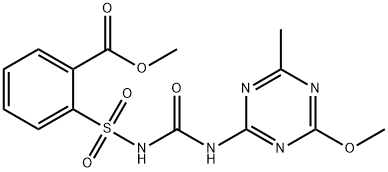Bensulfuron methyl
- CAS NO.:83055-99-6
- Empirical Formula: C16H18N4O7S
- Molecular Weight: 410.4
- MDL number: MFCD00128064
- EINECS: 401-340-6
- SAFETY DATA SHEET (SDS)
- Update Date: 2025-10-23 17:25:30

What is Bensulfuron methyl ?
Description
Bensulfuron-methyl (BSM) is a new kind of sulfonylurea herbicide widely used to control various weeds and sedges. It is moderately soluble in water, non-volatile and moderately mobile. It would not be expected to persistent in soil but could be persistent in water systems under certain conditions. It is not highly toxic to mammals. It also shows a low toxicity to birds and earthworms but is more of a concern to aquatic plants, algae and honeybees.
The Uses of Bensulfuron methyl
Bensulfuron methyl (BSM) was the first sulfonylurea herbicide commercialized for use in rice, and it remains the dominant sulfonylurea for broadleaf and sedge weed control in this crop.
Definition
ChEBI: Bensulfuron-methyl is the methyl ester of bensulfuron. An acetolactate synthase inhibitor, it is used as a herbicide for the control of a variety of both annual and perennial weeds in crops, particularly wheat and rice. It is not licensed for use within the UK. It has a role as a herbicide, an agrochemical and an EC 2.2.1.6 (acetolactate synthase) inhibitor. It is a N-sulfonylurea, a member of pyrimidines, a methyl ester and an aromatic ether. It derives from a bensulfuron.
Safety Profile
Moderately toxic by ingestion.When heated to decomposition it emits toxic vapors ofNOx and SOx.
Metabolic pathway
Bensulfuron methyl is metabolized by mammals and birds and the major metabolites identified include mono-O-demethylated and 5-hydroxylated bensulfuron methyl and 5-hydroxy-2-amino-3,5- dimethoxypyrimidine. As bird metabolites, cleavage of the pyrimidine ring of bensulfuron methyl is observed which results in two pyrimidine ring-opening metabolites. In rice plants, bensulfuron methyl undergoes rapid O-demethylation at one of the methoxy groups on the pyrimidine ring which will proceed through hydroxylation at the methyl group. Alcoholysis and hydrolysis of bensulfuron methyl (H1) involve mainly the breakdown of the urea moiety which leads to several degradation products, some of which are also identified as metabolites in mammals and plants.
Properties of Bensulfuron methyl
| Melting point: | 185-188°C |
| Density | 1.4087 (rough estimate) |
| refractive index | 1.6000 (estimate) |
| storage temp. | 0-6°C |
| solubility | Acetonitrile (Slightly), Dichloromethane (Slightly), DMSO (Slightly) |
| pka | 12.34±0.70(Predicted) |
| form | Solid |
| form | neat |
| color | White to pale yellow |
| Odor | odorless solid |
| BRN | 7447488 |
| Stability: | Moisture Sensitive, Unstable in Solution |
| CAS DataBase Reference | 83055-99-6 |
| EPA Substance Registry System | Bensulfuron-methyl (83055-99-6) |
Safety information for Bensulfuron methyl
| Signal word | Warning |
| Pictogram(s) |
 Exclamation Mark Irritant GHS07  Environment GHS09 |
| GHS Hazard Statements |
H317:Sensitisation, Skin H410:Hazardous to the aquatic environment, long-term hazard |
| Precautionary Statement Codes |
P261:Avoid breathing dust/fume/gas/mist/vapours/spray. P272:Contaminated work clothing should not be allowed out of the workplace. P273:Avoid release to the environment. P280:Wear protective gloves/protective clothing/eye protection/face protection. P302+P352:IF ON SKIN: wash with plenty of soap and water. P333+P313:IF SKIN irritation or rash occurs: Get medical advice/attention. |
Computed Descriptors for Bensulfuron methyl
| InChIKey | XMQFTWRPUQYINF-UHFFFAOYSA-N |
Bensulfuron methyl manufacturer
New Products
4,4-Difluoropiperidine hydrochloride tert-butyl 9-methoxy-3-azaspiro[5.5]undecane-3-carboxylate Indole Methyl Resin N-Isopropylurea N,N-Dicyclohexylcarbodiimide(DCC) MELDRUMS ACID 5-METHYLISOXAZOLE-4-CARBOXYLIC ACID Magnessium Bis glycinate Zinc ascorbate 1-bromo-2-butyne 2-acetamidophenol 9(10H)-anthracenone Erythrosin B, 4-Piperidinopiperidine 2-((4-morpholinophenylamino) (methylthio) methylene) malononitrile 2,4-dihydroxybenzaldehyde 3-(4-morpholinophenylamino)-5-amino-1H-pyrazole-4-carbonitrile Methyl 2-methylquinoline-6-carboxylate 2,6-dichloro-4-nitropyridine 4-Bromo-2-chlorobenzonitrile 2-(benzylamino)acetic acid hydrochloride 4-(tert-Butoxycarbonylamino)but- 2-ynoic acid 3,4-dihydro-2H-benzo[b][1,4]dioxepine 1-Phenyl-1-cycloprppanecarboxylicacidRelated products of tetrahydrofuran








You may like
-
 Bensulfuron-methyl CAS 83055-99-6View Details
Bensulfuron-methyl CAS 83055-99-6View Details
83055-99-6 -
 Bensulfuron-methyl CAS 83055-99-6View Details
Bensulfuron-methyl CAS 83055-99-6View Details
83055-99-6 -
 3-(4-amino-1-oxoisoindolin-2-yl)-1-methylpiperidine-2,6-dione 98%View Details
3-(4-amino-1-oxoisoindolin-2-yl)-1-methylpiperidine-2,6-dione 98%View Details -
 614-19-7 98%View Details
614-19-7 98%View Details
614-19-7 -
 20677-73-0 (2,2-diethoxyethyl)methylamine 98%View Details
20677-73-0 (2,2-diethoxyethyl)methylamine 98%View Details
20677-73-0 -
 3-(4-(hydroxyamino)-1-oxoisoindolin-2-yl)piperidine-2,6-dione 98%View Details
3-(4-(hydroxyamino)-1-oxoisoindolin-2-yl)piperidine-2,6-dione 98%View Details -
 57381-49-4 2-bromo-4-chlorobenzonitrile 98%View Details
57381-49-4 2-bromo-4-chlorobenzonitrile 98%View Details
57381-49-4 -
 4,6-dichloropyrimidine-5-carbaldehyde 98%View Details
4,6-dichloropyrimidine-5-carbaldehyde 98%View Details
5305-40-8
